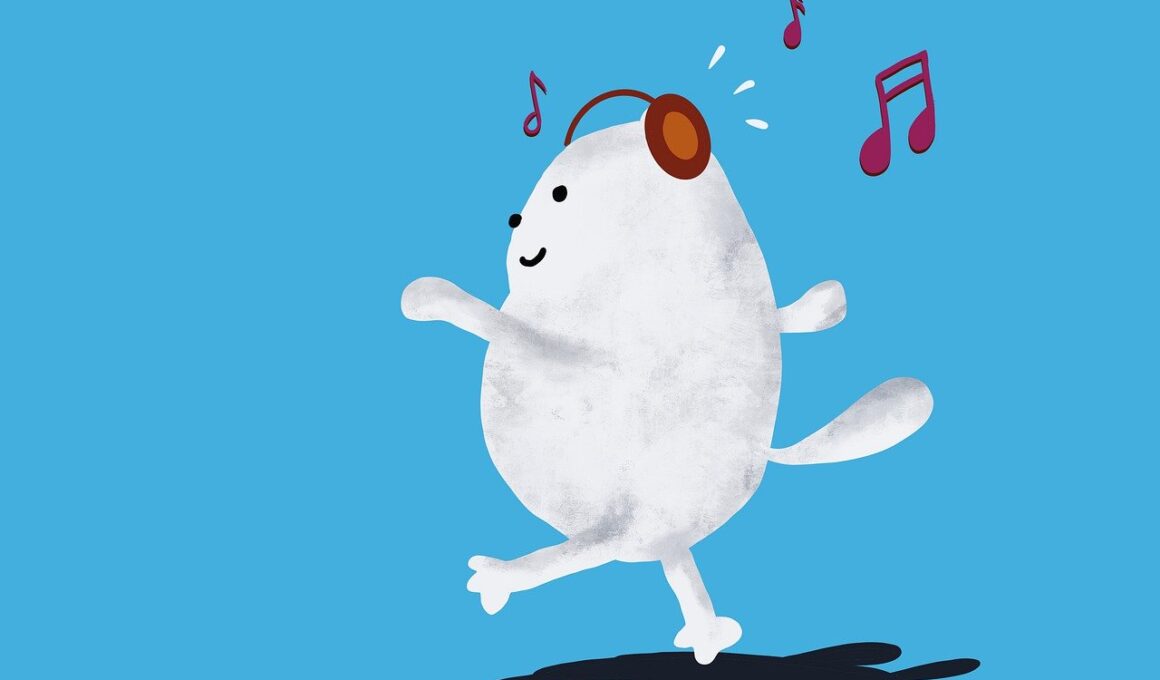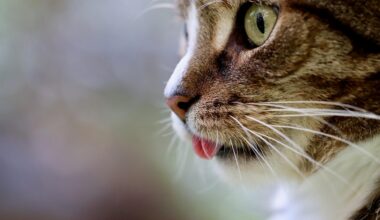How Cats Interpret Sounds in Their Surroundings
Understanding how cats perceive sounds is crucial for pet owners, as it helps foster better communication between them and their feline companions. Cats have a highly developed sense of hearing, which allows them to detect a wide range of frequencies, significantly higher than humans can. While humans hear sounds within the range of 20 Hz to 20 kHz, cats can hear frequencies as high as 65 kHz. This superior auditory sensitivity enables them to pick up on subtle environmental cues, which can be essential for their survival in the wild. They can easily hear high-pitched noises, such as the rustling of a small rodent, which directly impacts their hunting capabilities. For pet owners, understanding this natural behavior can help create a more harmonious living environment. For instance, during interactions, understanding how sound affects them can lead to more effective communication. Owners can speak in softer tones, while ensuring their cat feels safe. To support their auditory needs, providing toys that mimic natural sounds can stimulate their innate instincts. Each of these aspects illustrates their unique relationship to sound and how it shapes their perception of the world.
The Impact of High-Pitched Sounds
Cats are particularly responsive to high-pitched sounds, which are relevant to their natural behaviors, such as hunting. Many cat toys are designed to produce these frequencies, engaging their hunting instincts effectively. The high pitch mimics what their prey would sound like, making it easier for cats to focus and interact with their environment. This natural attraction to these noises promotes physical activity and mental stimulation among indoor cats. Understanding this preference can guide owners in selecting toys that align with their pet’s instincts. For example, squeaky toys often simulate the sounds of small animals, thus encouraging playful behavior. On the other hand, loud, jarring noises can be frightening for a cat and create stress. Cats may react by hiding, which is a natural instinct for self-preservation. Therefore, observing their reactions to different sounds is pivotal. Owners should strive to create a calm acoustic environment, where pleasant sounds like gentle music can be included. It ensures that their home remains a safe haven where their cats can thrive emotionally and physically amidst that auditory landscape.
Another critical aspect of how cats perceive sounds is their ability to use auditory cues for navigation. Cats rely on sound to orient themselves in their environments, especially in low-light conditions. Their excellent hearing allows them to hone in on familiar sounds, including their owner’s voice or the rustling of familiar objects. For instance, they might recognize the specific sound that their food bowl makes when it hits the floor, associating it with the arrival of a meal. This learning helps cats navigate their homes and signal when they need assistance. Additionally, cats use sound to communicate with each other, such as chirps and trills. This vocal variety supports their social dynamics, enabling them to express needs and emotions effectively. Owners can benefit from understanding these nuances. By observing their cat’s response to specific sounds, owners can adjust their behavior to improve interactions. Familiar sounds can cultivate a sense of security. Knowing when to call their cat softly, or introducing a sound cue when feeding can reinforce positive behaviors and further strengthen their bond.
Environmental influences also play a significant role in how cats interpret sounds. Cats are sensitive to their surroundings and can quickly adapt to various auditory environments. For example, urban cats may have to learn to distinguish between traffic noises, sirens, and pet-related sounds. Such adaptability showcases their resilience and ability to thrive despite potentially stressful environments. However, exposure to sudden and loud noises can lead to anxiety and stress in some cats. Common sources of these triggers include thunderstorms, fireworks, and loud machinery. Owners should be mindful of this sensitivity and create a safe space for their pets during such events. Providing a quiet area with comforting bedding can reduce stress levels and promote a sense of security. Further, methods such as desensitization—gradually exposing cats to less overwhelming sounds—could be beneficial. Ultimately, awareness and proactive strategies significantly affect their overall well-being and comfort in various environments. By ensuring an accommodating living space, cat owners can positively contribute to their pet’s mental health and happiness.
Training and socialization experiences also influence how cats perceive sounds. Early exposure to different auditory stimuli prepares cat breeds for various environments. Kittens that experience diverse sounds become more adaptable adults. For instance, exposing them to household noises like vacuum cleaners or doorbells can normalize those sounds over time. This exposure helps reduce fear responses, improving their confidence. Furthermore, engaging with the cat through sound can strengthen the bond. A cat that responds positively to its owner’s voice will generally feel safer and more secure. Additionally, introducing sounds during feeding times or play can create positive associations. Cats are more likely to engage in behaviors that lead to rewarding auditory feedback. Socializing with a variety of environments can also enhance their skills in dealing with noise. Those living in more chaotic settings need adequate attention and training to help them manage their emotional responses. Therefore, interactive and positive training experiences can play a significant role in shaping how cats view their auditory environment, fostering a calmer and happier pet.
Moreover, subtle vibrations also communicate important information to cats, forming part of their perception of environment sounds. Cats are sensitive to low-frequency vibrations in their surroundings, which can indicate nearby dangers or attractive sources of prey. For example, the vibrations created by footsteps or the rustle of leaves can signal that something is moving nearby, often prompting a cat to investigate. Additionally, these vibrations can help cats communicate with each other, as they may sense each other’s presence through the ground’s subtle shifts. This awareness facilitates social interactions and territorial behaviors. Understanding these elements can help cat owners create interactions that satisfy these instincts, reinforcing their security in the home. For instance, playing with vibrating toys can stimulate their innate understanding of hunting and prey behavior. Owners can also motivate their cats by incorporating textures or movements that suggest organic interactions with their environment. A dynamic living space that acknowledges a cat’s perception of sounds and vibrations fosters healthy habits. Thus, combining sound awareness with tactile stimulation promotes overall engagement and happiness for pet cats.
The emotional connection that cats forge through sound is an essential aspect of their psychology. Cats communicate their feelings not just through body language, but also through vocalizations, which vary in pitch, tone, and volume. Cats may develop specific sounds to signal specific needs to their owners. The well-known meow can take on different meanings depending on the pitch and frequency, indicating hunger, discomfort, or excitement. Understanding these cues enriches the human-feline relationship, allowing owners to become attuned to their pets’ needs. Owners can effectively respond to a cat’s vocalizations to foster trust and security. Additionally, responding promptly to sounds, whether playful chirps or distress calls, reinforces positive communication. Cats thrive in environments where they feel heard. Creating scenarios where they can express themselves, such as with interactive toys that mimic prey sounds, ensures they feel understood. Social structures that encourage vocal interactions between owner and pet nurture emotional connections. Tailoring the interactions further enhances their overall well-being while embedding a deeper bond. Consequently, the interplay of sound, emotion, and psychology shapes how cats interact with their surroundings.
Consequently, understanding how cats interpret sounds can enhance their quality of life. Awareness of a cat’s auditory perception leads to a well-rounded approach to pet care. Owners who consider their cats’ diverse sounds develop richer interactions that resonate positively with their pets. Providing engagement through sound-rich environments aids in physical health and emotional satisfaction. For instance, incorporating background music can soothe anxious cats or encourage playful responses. Additionally, establishing a noise-friendly space enhances comfort, especially during stressful events like thunderstorms. Also, familiar noises like rattling food bowls or opening treats can elicit excitement and anticipation. Such an environment empowers cats by aligning with their natural instincts and behaviors. Furthermore, proactive measures to identify stressors related to sound allows for immediate adaptations to their surroundings, ultimately benefitting their emotional well-being. In closing, the complex relationship between cats and their auditory environment reveals vital insights into their psychology. Recognizing the nuances of how cats perceive sounds can guide pet owners in crafting enriching experiences, ensuring healthier, happier lives for their feline companions.


